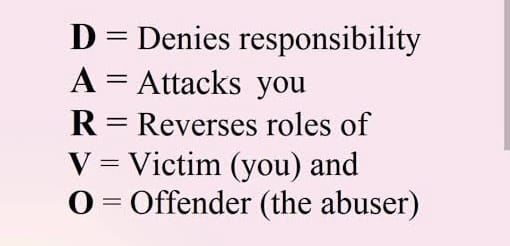Exposing the DARVO Response - A Manipulative Tactic of Narcissists and Abusers

What is DARVO?
DARVO is an acronym that stands for Deny, Attack, and Reverse Victim and Offender. It is a manipulative tactic used by narcissists and abusers to deflect blame and avoid accountability for their actions.
Understanding DARVO
DARVO is a common strategy used by perpetrators of wrongdoing, including sexual offenders, to shift the focus away from their own behavior and onto the victim or those who dare to confront them.
The DARVO Response: A Closer Look
When confronted with their misdeeds, individuals employing the DARVO tactic will typically:
- Deny any wrongdoing, even when faced with irrefutable evidence
- Attack the credibility, character, or motives of the accuser or victim
- Reverse the roles of victim and offender, portraying themselves as the true victim
The Devastating Impact of DARVO
The DARVO response can have a profound impact on victims, causing them to question their own perceptions, sanity, or memory. It can also create a culture of silence, where others are reluctant to speak out against the perpetrator for fear of being attacked or discredited.
The DARVO Process
The DARVO process is a manipulative tactic employed by narcissists and abusers to deflect accountability and shift the focus away from their own wrongdoing. This insidious technique is used to silence and control victims, and it is essential to understand the different stages to recognize when it is being used against you or someone else.
Deny: The Perpetrator's Initial Response
The perpetrator denies any wrongdoing or responsibility, often with a straight face and a convincing tone. This initial denial is crucial in setting the stage for the rest of the DARVO process. By denying any culpability, the perpetrator creates a sense of doubt and uncertainty, making it harder for others to believe the victim's account.
Attack: The Perpetrator's Aggressive Counterattack
When the perpetrator is confronted with evidence or accusations, they launch a vicious counterattack against the victim or accuser. This attack can take many forms, including character assassination, gaslighting, or even physical intimidation. The goal is to make the victim doubt their own perceptions, memory, or sanity.
Reverse Victim and Offender: The Perpetrator's Masterful Manipulation
In a stunning display of audacity, the perpetrator reverses the roles of victim and offender, portraying themselves as the victim. This brazen move is designed to elicit sympathy and support from others, while simultaneously further discrediting and silencing the real victim. By claiming to be the victim, the perpetrator effectively turns the tables and shifts the focus away from their own culpability.
Impact of DARVO
Devastating Consequences on Mental Health
DARVO can have a significant impact on the mental health of victims, leading to feelings of guilt, shame, and self-doubt. When a victim is met with DARVO, they may begin to question their own perceptions, memories, and sanity. This can lead to increased anxiety, depression, and even post-traumatic stress disorder (PTSD).
Perpetuating the Cycle of Abuse
DARVO can also perpetuate a cycle of abuse and manipulation, making it difficult for victims to seek help or escape the situation. By denying and blaming the victim, the abuser reinforces their own power and control, creating a sense of hopelessness and helplessness for the victim. This can lead to a sense of entrapment, making it even more challenging for the victim to seek support or leave the abusive relationship.
Recognizing and Resisting DARVO
The DARVO response is a manipulative tactic used by narcissists and abusers to silence and discredit their victims. To protect yourself from this type of emotional abuse, it's essential to educate yourself on the signs of DARVO and how it is used to control and manipulate others.
Education is Key
Understanding the DARVO response and its characteristics is crucial in recognizing when it's being used against you. Learn about the four components of DARVO:
- Deny: Abusers deny any wrongdoing or accountability
- Attack: Abusers attack the victim's character, credibility, or sanity
- Reverse: Abusers reverse the roles of victim and perpetrator
- Victim-Blame: Abusers shift the blame from themselves to the victim
Setting Clear Boundaries
When dealing with individuals who use DARVO tactics, it's essential to set clear boundaries and be assertive. This can include:
- Clearly communicating your needs and expectations
- Setting consequences for when those boundaries are not respected
- Being firm and assertive in your communication
Seeking Support
If you're a victim of DARVO, it's crucial to seek support from trusted friends, family, or mental health professionals. They can provide you with:
- Emotional support and validation
- Guidance on how to navigate the situation
- Help in developing a plan to protect yourself from further abuse











Comments ()